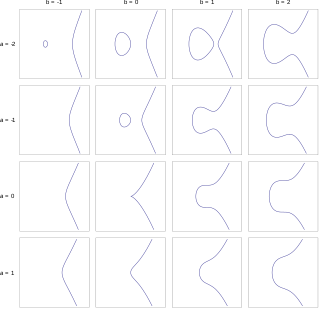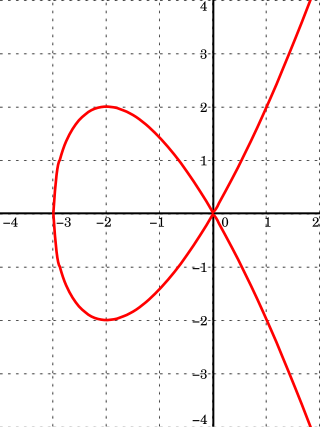
In mathematics, an elliptic curve is a smooth, projective, algebraic curve of genus one, on which there is a specified point O. An elliptic curve is defined over a field K and describes points in K2, the Cartesian product of K with itself. If the field's characteristic is different from 2 and 3, then the curve can be described as a plane algebraic curve which consists of solutions (x, y) for:

In mathematics, a field is a set on which addition, subtraction, multiplication, and division are defined and behave as the corresponding operations on rational and real numbers. A field is thus a fundamental algebraic structure which is widely used in algebra, number theory, and many other areas of mathematics.
In algebra, a homomorphism is a structure-preserving map between two algebraic structures of the same type. The word homomorphism comes from the Ancient Greek language: ὁμός meaning "same" and μορφή meaning "form" or "shape". However, the word was apparently introduced to mathematics due to a (mis)translation of German ähnlich meaning "similar" to ὁμός meaning "same". The term "homomorphism" appeared as early as 1892, when it was attributed to the German mathematician Felix Klein (1849–1925).

In mathematics, an isomorphism is a structure-preserving mapping between two structures of the same type that can be reversed by an inverse mapping. Two mathematical structures are isomorphic if an isomorphism exists between them. The word isomorphism is derived from the Ancient Greek: ἴσοςisos "equal", and μορφήmorphe "form" or "shape".
In abstract algebra, the field of fractions of an integral domain is the smallest field in which it can be embedded. The construction of the field of fractions is modeled on the relationship between the integral domain of integers and the field of rational numbers. Intuitively, it consists of ratios between integral domain elements.
In algebra, the kernel of a homomorphism is generally the inverse image of 0. An important special case is the kernel of a linear map. The kernel of a matrix, also called the null space, is the kernel of the linear map defined by the matrix.

In mathematics, the surreal number system is a totally ordered proper class containing not only the real numbers but also infinite and infinitesimal numbers, respectively larger or smaller in absolute value than any positive real number. Research on the Go endgame by John Horton Conway led to the original definition and construction of surreal numbers. Conway's construction was introduced in Donald Knuth's 1974 book Surreal Numbers: How Two Ex-Students Turned On to Pure Mathematics and Found Total Happiness.

In mathematics, exponentiation is an operation involving two numbers: the base and the exponent or power. Exponentiation is written as bn, where b is the base and n is the power; this is pronounced as "b (raised) to the n". When n is a positive integer, exponentiation corresponds to repeated multiplication of the base: that is, bn is the product of multiplying n bases:
In mathematics, more specifically in ring theory, local rings are certain rings that are comparatively simple, and serve to describe what is called "local behaviour", in the sense of functions defined on algebraic varieties or manifolds, or of algebraic number fields examined at a particular place, or prime. Local algebra is the branch of commutative algebra that studies commutative local rings and their modules.

In mathematics, division by zero, division where the divisor (denominator) is zero, is a unique and problematic special case. Using fraction notation, the general example can be written as , where is the dividend (numerator).

In mathematics, an affine algebraic plane curve is the zero set of a polynomial in two variables. A projective algebraic plane curve is the zero set in a projective plane of a homogeneous polynomial in three variables. An affine algebraic plane curve can be completed in a projective algebraic plane curve by homogenizing its defining polynomial. Conversely, a projective algebraic plane curve of homogeneous equation h(x, y, t) = 0 can be restricted to the affine algebraic plane curve of equation h(x, y, 1) = 0. These two operations are each inverse to the other; therefore, the phrase algebraic plane curve is often used without specifying explicitly whether it is the affine or the projective case that is considered.
In mathematics, there are several equivalent ways of defining the real numbers. One of them is that they form a complete ordered field that does not contain any smaller complete ordered field. Such a definition does not prove that such a complete ordered field exists, and the existence proof consists of constructing a mathematical structure that satisfies the definition.
In algebra, a valuation is a function on a field that provides a measure of the size or multiplicity of elements of the field. It generalizes to commutative algebra the notion of size inherent in consideration of the degree of a pole or multiplicity of a zero in complex analysis, the degree of divisibility of a number by a prime number in number theory, and the geometrical concept of contact between two algebraic or analytic varieties in algebraic geometry. A field with a valuation on it is called a valued field.
In mathematics, the notion of a germ of an object in/on a topological space is an equivalence class of that object and others of the same kind that captures their shared local properties. In particular, the objects in question are mostly functions and subsets. In specific implementations of this idea, the functions or subsets in question will have some property, such as being analytic or smooth, but in general this is not needed ; it is however necessary that the space on/in which the object is defined is a topological space, in order that the word local has some meaning.
This page lists some examples of vector spaces. See vector space for the definitions of terms used on this page. See also: dimension, basis.
In algebra, an absolute value is a function which measures the "size" of elements in a field or integral domain. More precisely, if D is an integral domain, then an absolute value is any mapping |x| from D to the real numbers R satisfying:

In mathematics, a rational number is a number that can be expressed as the quotient or fraction of two integers, a numerator p and a non-zero denominator q. For example, is a rational number, as is every integer. The set of all rational numbers, also referred to as "the rationals", the field of rationals or the field of rational numbers is usually denoted by boldface Q, or blackboard bold

In mathematics, a real number is a number that can be used to measure a continuous one-dimensional quantity such as a distance, duration or temperature. Here, continuous means that pairs of values can have arbitrarily small differences. Every real number can be almost uniquely represented by an infinite decimal expansion.
In mathematics, an algebraic number field is an extension field of the field of rational numbers such that the field extension has finite degree . Thus is a field that contains and has finite dimension when considered as a vector space over .
In mathematics, the field of logarithmic-exponential transseries is a non-Archimedean ordered differential field which extends comparability of asymptotic growth rates of elementary nontrigonometric functions to a much broader class of objects. Each log-exp transseries represents a formal asymptotic behavior, and it can be manipulated formally, and when it converges, corresponds to actual behavior. Transseries can also be convenient for representing functions. Through their inclusion of exponentiation and logarithms, transseries are a strong generalization of the power series at infinity and other similar asymptotic expansions.










